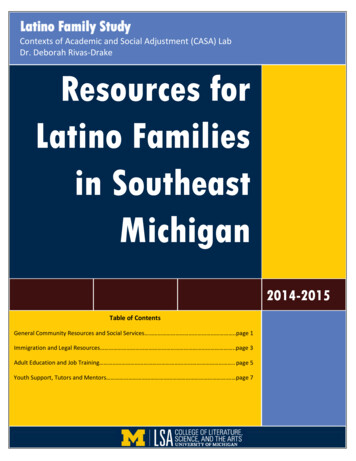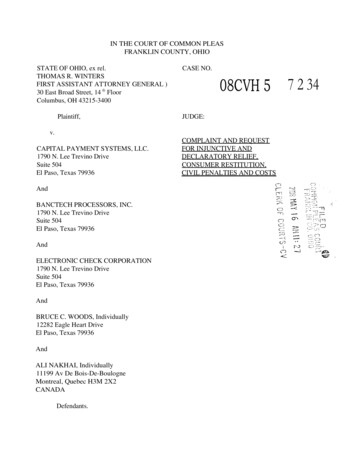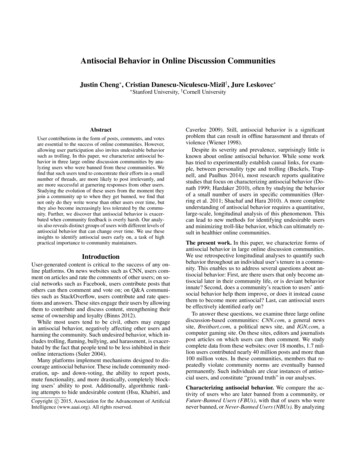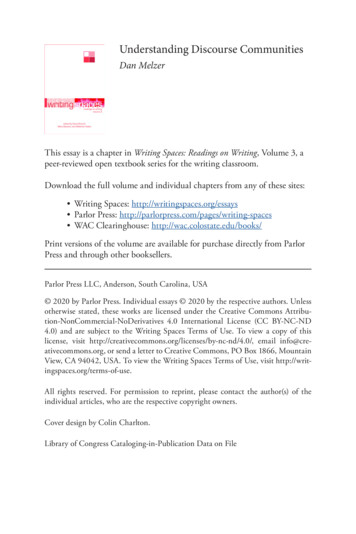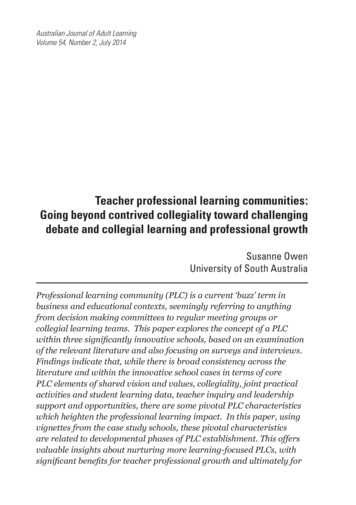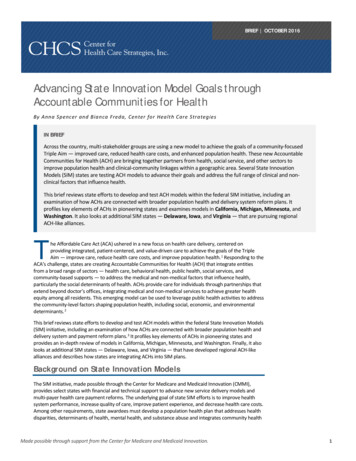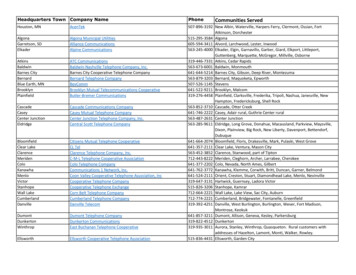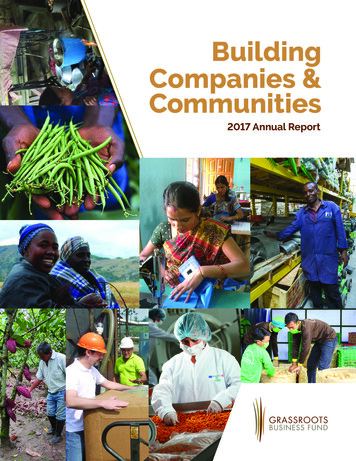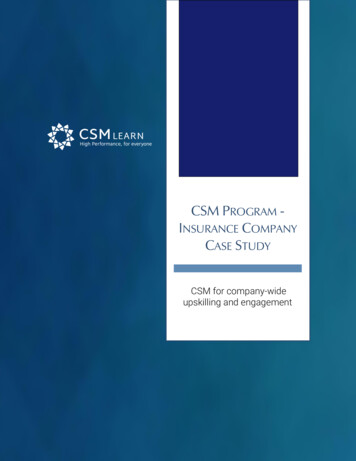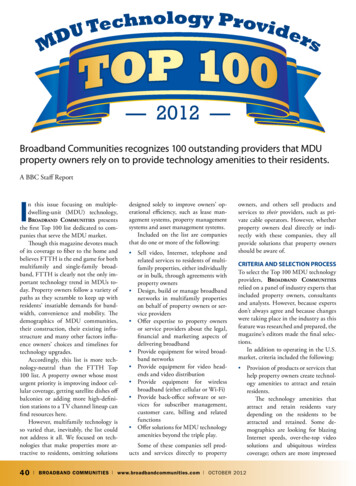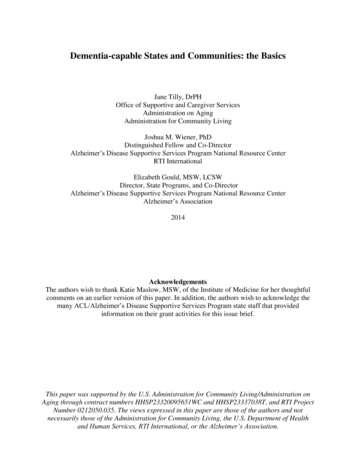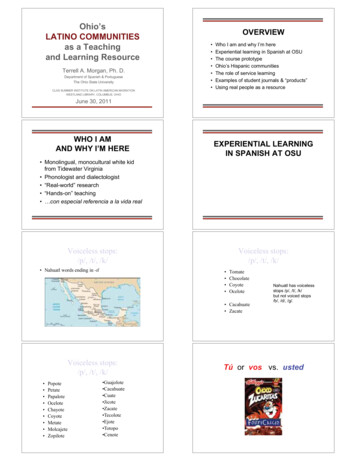
Transcription
Ohio’sLATINO COMMUNITIESas a Teachingand Learning ResourceTerrell A. Morgan, Ph. D.Department of Spanish & PortugueseThe Ohio State UniversityCLAS SUMMER INSTITUTE ON LATIN AMERICAN MIGRATIONWESTLAND LIBRARY, COLUMBUS, OHIOOVERVIEW Who I am and why I’m hereExperiential learning in Spanish at OSUThe course prototypeOhio’s Hispanic communitiesThe role of service learningExamples of student journals & “products”Using real people as a resourceJune 30, 2011WHO I AMAND WHY I’M HEREEXPERIENTIAL LEARNINGIN SPANISH AT OSU Monolingual, monocultural white kidfrom Tidewater Virginia Phonologist and dialectologist “Real-world” research “Hands-on” teaching con especial referencia a la vida realVoiceless stops:/p/, /t/, /k/ Nahuatl words ending in -tlVoiceless stops:/p/, /t/, /k/ TomateChocolateCoyoteOcelote Cacahuate ZacateVoiceless stops:/p/, /t/, /k/ ajeteZopilote Guajolote Cacahuate Cuate Jicote Zacate Tecolote Ejote Totopo CenoteNahuatl has voicelessstops /p/, /t/, /k/but not voiced stops/b/, /d/, /g/.Tú or vos vs. usted
EXPERIENTIAL LEARNINGIN SPANISH AT OSUPepsi vs. Pecsi OHIO’S HISPANICCOMMUNITIESTHE COURSE PROTOTYPE “Spanish in Ohio: An ExperientialCourse for Selected Majors” 35 hours of class in 5 weeks 100 hours outside of class in 10 weeks Journal, “product” “Study abroad” in Franklin County, Ohio Required of all who don’t study abroadProposal for new Spanish major, 1994Study-abroad requirementPublic universityVery small Hispanic community inCentral Ohio Maps & census figuresComparisons with rest of U.S.Two “historical” communities in OhioLatinos in ColumbusEthnolinguistic diversityU.S. Hispanic populationas percent of total, by countyOHIO’S HISPANICCOMMUNITIES Maps & census figuresComparisons with rest of U.S.Two “historical” communities in OhioLatinos in ColumbusEthnolinguistic diversityOhio Hispanic populationas percent of total, by countyOhio Hispanic PopulationOther uban2.4%Puerto Rican30.5%Mexican41.8%
OHIO’S HISPANICCOMMUNITIESU.S. Hispanic PopulationOhio Hispanic PopulationOther Hispanic18.8% Maps & census figuresComparisons with rest of U.S.Two “historical” communities in OhioLatinos in ColumbusEthnolinguistic 2.4%Puerto Rican30.5%U.S. Hispanic populationas percent of total, by countyOHIO’S HISPANICCOMMUNITIES Maps & census figuresComparisons with rest of U.S.Two “historical” communities in OhioLatinos in ColumbusEthnolinguistic diversityPercent by Origin of OhioHispanicbyp or Latino Populationpy CountyySizeofCircleDetermined bypanic ororLatinoSizeof ationperperCountyCountyTWO COMMUNITIES Northwest Ohio– From Mexico, 1950s– Rural counties– Migration to Toledo Northeast Ohio– From Puerto Rico, 1940s– Lorain (and other urban centers)Percent of Hispanic/Latino by OriginMexicanPuerto RicanCubanCentral AmericanSouth AmericanOtherSource: U.S. Bureau of the Census, Census 2000, Summary File 1UA/FYE Research & Analysis UnitOHIO’S HISPANICCOMMUNITIES21st-CENTURY TRENDS Immigrant overlay– Central & Southern Mexico– Guatemala, Honduras, El Salvador Strong Mexican influence– Press, entrepreneurship, consular office Dialects in contact Maps & census figuresComparisons with rest of U.S.Two “historical” communities in OhioLatinos in ColumbusEthnolinguistic diversityMexican41.8%
OHIO’S HISPANICCOMMUNITIES Google search: la michoacana columbus ohTraditional “Core Countries” ofThe Spanish-Speaking WorldMaps & census figuresComparisons with rest of U.S.Two “historical” communities in OhioLatinos in ColumbusEthnolinguistic diversity
NORTHWEST OHIO SPANISHSome Characteristic Features Phonology– Consonant-heavy– Intervocalic /y/ weakening and loss: ella, millas, ladrillo– Leveling of tap/trill distinction: Sierra, terrenoMorphology– Regularization and overgeneralization: la idioma– Loss of (especially verb) morphology: nosotros usara, somos bilingüe– Gender agreement: muchos experiencias– -ábamos -ábanosSemantics– Leveling of mood & aspect distinctionsLexicon– Asina, pos– Treilita, Minesora– Limited Spanish vocabularyDiscourse/other– Code mixing, circumlocution– Linguistic insecurityNORTHWEST OHIO SPANISH: JUANITA GUTIÉRREZ (FREMONT, OHIO)Buenas tardes. Mi nombre es Juanita Gutiérrez. Uh, tengo 43 años. Estoy casada;mi esposo se llama Manuel y tengo cuatro hijos--tres que están casados y tengo unhijo de 14 años que me queda en casa. Tengo tres nietos, y otro que viene porcamino. Este, yo eh nací aquí en Fremont, Ohio. Nací y fui criada aquí enFremont. Fui a la escuela en Bettsville, un pueblito del sur de aquí, que es comounos trece millas de aquí.
NORTHWEST OHIO SPANISH: JAIME SIERRA (DEFIANCE, OHIO)Me llamo Jaime Sierra. Uh, nací en el año 1963 en un pueblito en Ohio llamado Defiance,Ohio. Mis padres se mudaron ahi en los años 50 de este, del siglo pasado., y ahí criaronocho hijos, somos cuatro hombres y tengo cuatro hermanas. Yo soy la seis, el septo hijo delos ochos. Desde niños era muy importante hablar español en la casa. Como mis padresson de México es la idioma de ellos y era muy importante que nosotros podíamos hablar eseidioma y inglés. Pues, así eh, nos estuvimos (?) impuestos a hablar español en la casa, yluego en la escuela a hablar inglés. Y por esa razón hablo inglés y español. Pero yo creo quemi español ya no está tan, no, no lo hablo diaramente, diariamente, y por eso a veces no mesiento muy, no tengo mucha confianza cuando hablo en español. NORTHWEST OHIO SPANISH:LOUIS GUARDIOLA (FREMONT & GIBSONBURG, OHIO)Pues yo soy, yo nací en Fremont, Ohio. Y por un tiempo vivimos en Fremont. Desde cuando nacíhasta los seis años, porque fui al Head Start en Fremont, y fui a kindergarten, y luego después de esonos fuimos a vivir en Gibsonburg, que es una, un pueblito chiquito, y ahi vive mi abuelita, mi abuelitoy mi tía, que es un año mayor que que yo, y compramos una treilita--Is that how you say it?--treilita,trailer, house trailer, y um, y mi papá lo puso en el, en el, uh, ¿cómo se dice la, el yard, ¿cómo se diceyard? el terreno de mi abuelita, vivimos muy cerca porque ella vivía en una casa que más antes erauna escuela, (po)s era de esos A-frame de, de ladrillo, y uh y también vivía, y ese tiempo estabaviviendo mi ab-, mi bisabuelito--Is that how you say it, my great-grandfather?--y él um solamente misa-, mi abuelita, mi abuelito y mi bisabuelito hablaban solamente en español, so ahí es donde uhaprendí el, el español, que mi abuelita no nos dejó que habláran- hablaban- que nosotros usara elinglés, (---amos) que usar el español. Y a mí me enseñó a leer y escribir en español. Y también me,también me recuerdo que en las noches, cuando, pos vivímos allí en el en el uh, en el country, no sécómo se dice country en español, pero ahí en-, no vivimos ahí en en la ciudad, vivimos en el country,y pos las noches los pasábanos platicando, y mi abuelita nos platicaba de México y de Texas y miabuelita nos daba unos uh cuentos y unos, um, ¿cómo se dicen? um, como historias de, de, que teníanum que tenían poquito de sabor de, de, religioso, de Dios y los santos y asina. NORTHEAST OHIO SPANISH: FAMILIA RÍOS (LORAIN, OHIO)NORTHEAST OHIO SPANISHSome Characteristic Features Phonology– Consonant-weak– /s/ aspiration and (especially) deletion– Aspirated or velarized /r/– Lateralization of coda -rMorphology– Regularization and overgeneralization– Loss of (especially verb) morphology: los abuelos venir– Reanalysis of forms: el sijo for el hijo, based on plural [lo.sí.ho]Semantics– Leveling of tense, mood & aspect distinctionsLexicon– Limited Spanish vocabulary (creímos for criamos)Discourse/other– Code mixing, circumlocution– Linguistic insecurityOTHER OHIO SPANISHESMegan: Megan Laura Ríos. (And how old are you?) Nueve. Laura: Eh, Laura Alisea Ríos, 41 años. Kerwin: Y Kerwin Ríos. 41 años. Laura: Este es mi esposo Kerwin.mi hija Megan.tengo dos hijos.Antonio y Gabriel tienen veinte. ya s-, ya elmayor tiene veinte años y el otro tiene dieciocho. Nos creímos aquí en Lorain, Ohio parte de los padres, bueno losabuelos venir a Lorain a buscar trabajo en el s- eh, eh steel mill que queda en la Calle Veintiocho. También lamamá mía, ella vino de Nueve York. Ah, ella viene de de otro lado. El hermano de ella vino de Puerto Rico atrabajar aquí en el steel mill pero cuando mandó para la familia primero fueron a Nueva York, entonces vinieronaquí.Kerwin: El abuelo mío vino aquí primero para trabajar el steel mill en nineteen forty-six. Entonces trabajabacomo tres años antes a buscar la esposa en la.y las sijas ( las hijas) y el sijo. El tío mio trabajaba allí también ymi papá trabajaba allí en nineteen forty-seven, cuarenta años trabajando allí. ¿Qué más? ¿Qué más? Ah, yonacido aquí en Lorain so mi español un poquito [risas] y yo trabajaba.yo son labor worker, mi esposa es unmanager en (?) compañía. Ella está yendo a un colegio.Laura: Sí, yo, yo soy estudiando ahora.Kerwin: Ella está estudiando y trabajando.JUDEO-SPANISH (LADINO, JUDEZMO):FAMILIA JERUSALMI (CINCINNATI, OHIO) Judeo-Spanish (Ladino, Judezmo)– From Spain, 1492– Via Istanbul (400 years)– Cincinnati (3 months ago) “Other Hispanic”– From all over Spanish-speaking world– Isolated households or entire communitiesA NOTE ABOUTLanguage, Dialect, and Social ClassA NOTE ABOUTSpanglish
CALEBISMSONE CASE OF COMPETING LANGUAGES:Whoever arregla el árbol puede serel árbol's friend. (7.VII.97)Bilingual language acquisitionShut up means que be quiet. (15.XI.98)El agua's gonna be fría if you don'thurry up, Rubén. (24.X.00)(Documentation of language developmentof my sons Caleb and Ruben)RUBENISMSI let my brother my dump truck for play he.(24.XII.98, to his English-speaking grandparents)Cuando la mamá taked me a la escuela,he taked mi almohada. (2.IX.99)Do you think que sí? I think que no. (7.IX.99)THE ROLE OFSERVICE LEARNING What is “Service Learning”?http://service-learning.osu.edu/THE ROLE OFSERVICE LEARNING What is “Service Learning”?http://service-learning.osu.edu/ Benefits– Gives us all purpose– Addresses community needs– Learning increases exponentially language skills retention excitementSERVICE LEARNINGSERVICE LEARNING community partners (including schools) training (professionalization) opportunities for extra-curricular serviceand learning, even jobs outcomes include tangible products community partners (including schools) training (professionalization) opportunities for extra-curricular serviceand learning, even jobs outcomes include tangible products
SERVICE LEARNING community partners (including schools) training (professionalization) opportunities for extra-curricular serviceand learning, even jobs outcomes include tangible productsEXAMPLES OFSTUDENTJOURNALS & PROJECTStangible productsEXAMPLES OFSTUDENTJOURNALS & PROJECTSJOURNALS borationEXAMPLES OFSTUDENTJOURNALS & PROJECTS
Good Food forBuena SaludReframing the concept ofcooking and eatingLatinos in OhioA Representation of CulturalSignificance in Columbus, OHartifact box
Artifact #1 LATIN FOODSTAPLESArtifact #1LATIN FOOD STAPLES: Goya Frijoles Negros Goya QuinuaPRACTICEQuinua is made into a salad similar to Mediterranean cous cous and is aPeruvian, Ecuadorian and Bolivian staple. The aforementioned Latin Americancountries are the three top producing countries in the exportation of Quinua. On thepackage is included a recipe for a Peruvian Quinua stew made with pork, Goya Adobo with Pepper and various other Goya products.Frijoles Negros, or Black beans are served nearly everywhere in Latin Americawith rice or alone. Frijoles Negros comprise the national food of Brazil, Feijoadawhich is a stew of beans with various beef and pork products.PERSPECTIVEIn the countries of Peru, Ecuador and Bolivia the Quinoa crop has beencultivated for 1,000’s of years. The Incas, who held the crop to be sacred, referred toquinoa as "chisaya mama" or "mother of all grains", and it was the Inca emperor whowould traditionally sow the first seeds of the season using ‘golden implements’. InAnglo culture the crop that supports our livelihood is a grain as well, wheat.Beans are also a staple of Anglo culture as Americans are dependant on thesoybean and soybean oil for 100’s of products and as a legume to provide nitrogen forU.S. corn fields. The Goya heat and serve sopa de frijoles negros is a uniquerepresentation of the Latin@ lifestyle that is hard working and trying to keep up with asociety at a much faster pace than that of their native country.Artifact #2: RELIGION CANDLE of the VIRGEN DEGUADALUPE ANGEL GUARDIAN CANDLE ROSARY of the VIRGEN DEGUADALUPEPERSPECTIVESThe Virgin Mary appeared in 1531 on December 12 to Juan Diego,a converted native of Mexico. The miracle of her appearance led to theconversion of hordes of people in Mexico to Catholicism. Additionally, it isparadoxical that an image of an important aspect of the religion of theoppressor graced the banners of Padre Miguel Hidalgo y Costilla, father ofMexican Independence, as he led the country in 1810 through 10 years ofwar for liberation from Spain.Our lady of Guadelupe is an image of the Virgin Mary-the motherof Jesus, whom Christians believe to be the son of God. In Anglo-SaxonCatholic churches, and Christian homes, images of the Virgin Mary adornthe walls as well as Mexican American homes and Churches. To Anglosshe is, more often than not, shown light skinned-even though she was fromthe Middle East. The Virgin of Guadelupe is said to have appeared in 1531as brown-skinned-a Mestizo, and is depicted as so.FRIJOLES NEGROSQUINUAPRODUCTGoya quinua seeds, 12 oz, a product of Peru and Goya heat andserve sopa de frijoles negros, 15 oz. The black bean soup contains water,black beans, vinegar, corn oil, salt, olive oil, dehydrated onio
Mis padres se mudaron ahi en los años 50 de este, del siglo pasado., y ahí criaron ocho hijos, somos cuatro hombres y tengo cuatro hermanas. Yo soy la seis, el septo hijo de los ochos. Desde niños era muy importante hablar español en la casa. Como mis padres son de México es la idioma de ellos y era muy importante que nosotros podíamos hablar ese idioma y inglés. Pues, así eh, nos estu
